- February 25, 2024
How to Tell If a Nursing Cat Is Pregnant Again: 5 Vet-Reviewed Signs to Look For
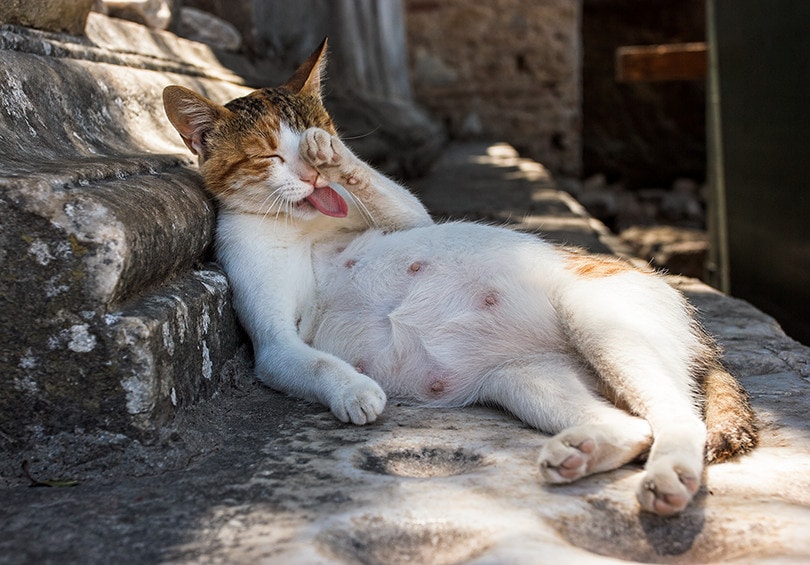
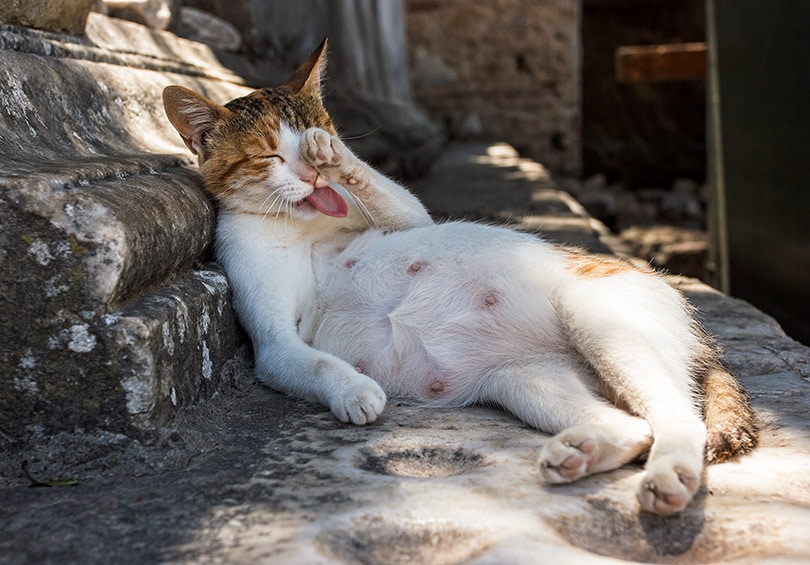

The information is current and up-to-date in accordance with the latest veterinarian research.
Cats are known for being exceptionally fertile, with one female being capable of having up to three litters per year. When a nursing mother cat is busy caring for her kittens, you may not think she’d be at risk of becoming pregnant while nursing, but it can definitely happen.
Just because a cat is lactating and actively nursing, doesn’t mean the heat cycle is suppressed. In fact, females can go into heat in as little as 2 weeks after giving birth. Being able to tell if a nursing mother cat is pregnant again may be a little harder to detect, but there are still some signs you can look for.

The 5 Signs on How to Tell If a Nursing Cat Is Pregnant Again
1. Noticeable Weight Gain
It’s no surprise that weight gain is the most noticeable sign of pregnancy, and it’s probably the biggest indicator that a nursing cat has fallen pregnant again. Your average female cat will gain anywhere from 2 to 4 pounds during pregnancy, and the majority of that weight will be lost following the birth of her kittens.
Cats are only pregnant for 63 to 65 days, so depending on how quickly she went into heat after giving birth, you may start noticing her abdomen begin to enlarge due to the new group of growing fetuses. Pregnancy is typically noticeable around the 5-week mark, so there’s a chance the kittens will have already weaned in some cases since kittens will nurse for about 4 to 6 weeks.
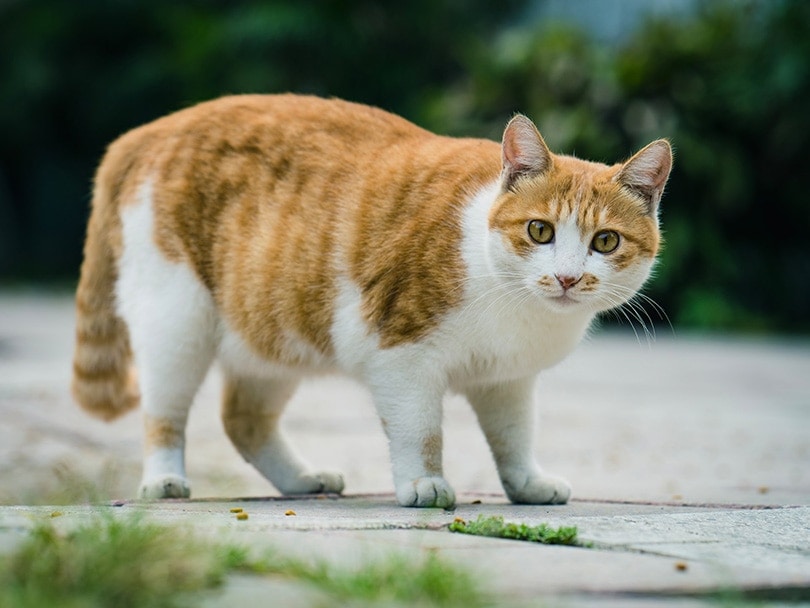
2. Increased Appetite
Increased appetite is a very common sign of pregnancy since the mother is needing enough nutrients to sustain herself and her unborn kittens. This is also very common among nursing mothers since they also need a lot of extra nutrients for nursing, so it may be hard to differentiate between the two.
If your nursing mother cat has gone through a heat cycle, has had access to an unaltered male, and has shown a drastic increase in appetite as she’s been nursing, there’s a good chance she could be pregnant.
3. Sleeping a Lot
You may notice excessive sleepiness as a sign that your nursing cat is expecting. This is due to the drastic hormonal changes that occur with pregnancy. Keep in mind this is also common for nursing mothers, as they are also expending a lot of energy from nursing.
It’s also completely normal for cats to sleep from 12 to 18 hours each day. In the wild, cats need all the energy they can muster for hunting, chasing, and succeeding in taking down their next meal, so sleeping a lot is a natural behavior across the feline family.
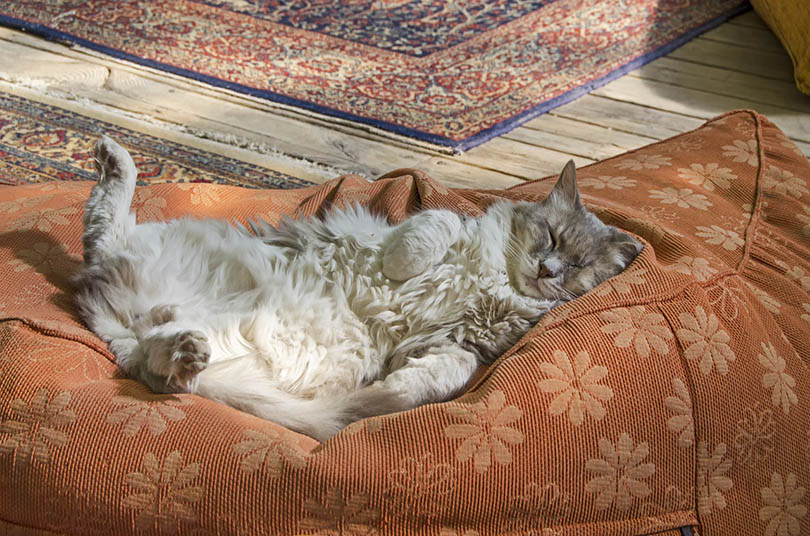
4. Vomiting
Pregnant queens may sometimes experience what humans call “morning sickness.” Just like with humans, feline mothers-to-be may become nauseous and vomit on occasion. This is also a result of hormonal changes that occur.
It’s important to keep an eye on vomiting, and if it becomes frequent and continuous you will need to contact your veterinarian right away. A nursing cat needs all the nutrients she can get; excessive vomiting could result in malnourishment, dehydration, or be a sign of another underlying health concern.
5. Behavioral Changes
Changes in behavior can indicate a possible pregnancy, though it’s certainly not always the case. Cats may show changes in behavior for a variety of reasons, especially while they are nursing. Caring for kittens requires a lot of the mother’s time and energy, so she may not start acting like herself until after the litter has weaned.
More often than not, behavioral changes during a cat’s pregnancy are more subtle. Some may become more loving, while others may become more aloof or even display more defensive behavior. The biggest changes in behavior will likely occur when she is getting close to giving birth, in which the first litter would already be weaned.
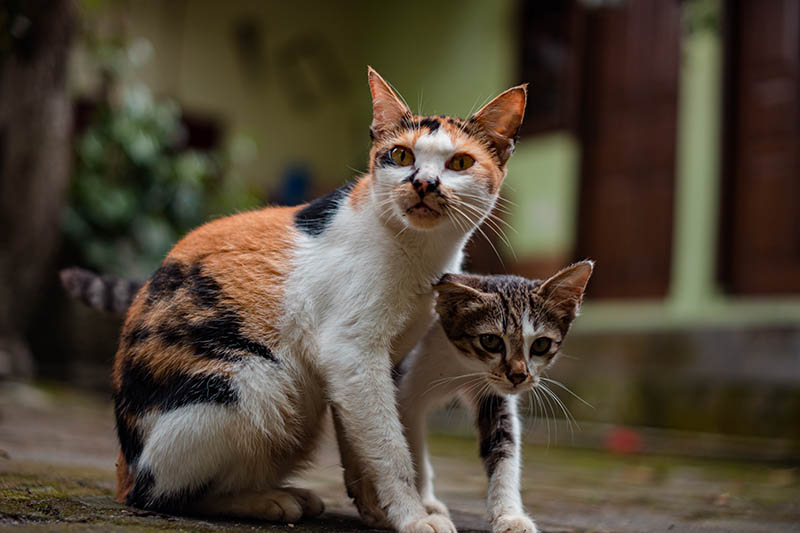

How to Definitively Diagnose Pregnancy in Cats
Getting a clinical pregnancy diagnosis is not always necessary but can be very helpful if you have any doubts about a potential pregnancy and/or you would like your cat to be thoroughly examined to ensure she is in good health and being cared for properly.
There are several ways that a veterinarian can definitively diagnose pregnancy in cats. The method may vary depending on your clinic, preferences, and overall cost.

Ways a Veterinarian May Perform a Clinical Diagnosis
Palpating the Abdomen
A veterinarian may be able to feel the fetus by palpating, or gently pressing on, the abdomen. This won’t work in the earliest stages of pregnancy but may be an effective method starting between 3 and 4 weeks into the pregnancy. This is undoubtedly the least invasive way to confirm pregnancy.
Ultrasound
Just like with humans, an ultrasound is able to detect fetuses. Scans are usually done from around week 3 of pregnancy when fetal heart beats can be seen. Not all veterinary clinics will have access to an ultrasound machine, and the price for this type of medical imaging can be pricey.
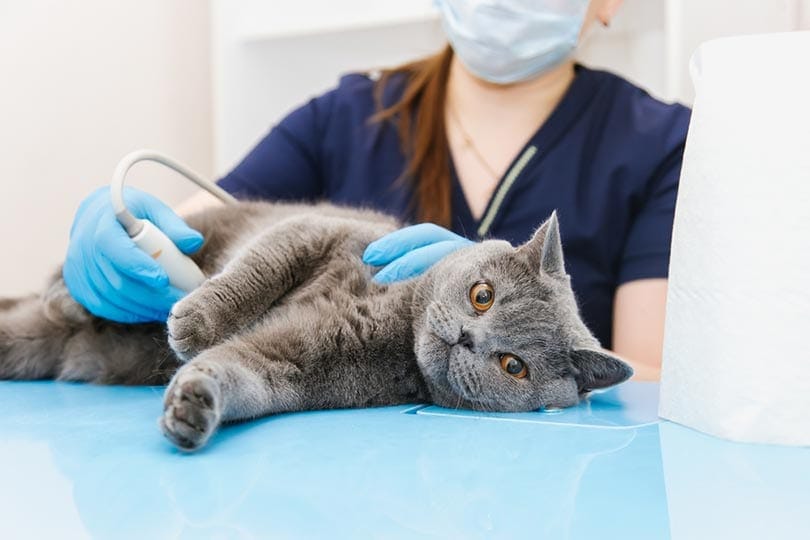
X-Ray
An X-ray or radiograph of the female’s abdomen can be performed to definitively diagnose pregnancy and to help determine the number of kittens in the litter the kittens’ skeletons develop in the last 3-4 weeks of pregnancy. X-rays are not always accurate in telling how many kittens are coming, and typically are not as effective, nor as safe, until after day 42 of pregnancy.
Pregnancy Test
Yes, pregnancy tests for cats do exist, but they are a bit different than your human test where you pee on a stick and have the results within minutes. This type of test is typically only necessary when the veterinarian is either unsure or cannot perform any other diagnostic test, which isn’t often. This test requires a blood sample to test the levels of the hormone relaxin, which is often present starting around day 25 after conception. These tests are costly and often are not necessary.

Preventing Pregnancy While a Mother Cat is Nursing
As a cat owner or caretaker, you are responsible for their health and wellbeing. It’s very important to prevent unwanted pregnancy by doing your due diligence and preventing it from happening in the first place. Talk to your veterinarian if you have any questions, but here are some of the best ways to prevent future pregnancies whether your cat is currently nursing or not.
- Have all cats in the home spayed and/or neutered.
- Keep your cat indoors at all times.
- Do not allow your female to have access to any intact males.
Why You Should Consider Spaying/Neutering

If you are not a cat breeder and do not have a purebred cat that is going to be used in a breeding program, it’s important to have them spayed or neutered as soon as possible. Female cats can go into heat and begin breeding as young as 4 months of age. Males will typically reach sexual maturity around 6 months of age, but it can happen sooner.
There is a companion animal overpopulation crisis occurring all over the world, with nearly 2 million cats being euthanized each year in the United States alone. Spaying and neutering are critically important to help prevent further overpopulation. There are plenty of other benefits associated with spaying and neutering, too.
Benefits of Spaying Female Cats
- They will not experience heat or estrus cycles
- Eliminates unwanted behaviors related to heat cycles
- Reduced risk of mammary gland tumors
- Reduced or eliminated risk of ovarian and/or uterine cancer, especially if spay is done before the first heat cycle
Benefits of Neutering Male Cats
- Reduces or eliminates the risk of spraying and urine marking
- Less desire to roam
- Reduced risk of fighting other cats
- Eliminates the risk of testicular cancer
- Reduced risk of prostate issues (rare in cats)
What If I Can’t Afford to Have My Cat Spayed/Neutered?
Plenty of pet owners shy away from spaying or neutering their animals because of the associated costs of the surgery. If you have an unaltered cat, do some research, or contact your local animal shelter to get resources and information about spay and neuter clinics in your area. There are often low-cost options available in most communities for those that can’t afford to pay full price at a veterinary clinic.


Conclusion
There are a few signs you can look for to determine whether your nursing cat is pregnant. Unfortunately, a lot of these signs are also related to nursing, aside from rapid weight gain and an enlarged abdomen. You can always opt for a clinical diagnosis from your veterinarian to confirm your suspicion. It’s important to take preventative measures to keep your nursing mother cat from becoming pregnant again and we encourage speaking to your veterinarian about the benefits and importance of spaying and neutering.
Featured Image Credit: Lenar Musin, Shutterstock
Tags
What do you think?
Related Articles

New Puppy Checklist: Gear You’ll Need for Your New Dog
Getting a new puppy is really exciting, but before you welcome them home, it’s important to prepare your space for them. Since puppies need a

How Big Do Mini Poodles Get? Vet Reviewed Average Weight & Growth Chart – Dogster
The information is current and up-to-date in accordance with the latest veterinarian research. Learn more » When you buy a Miniature Poodle, you might not

Can Police Dogs Smell Nicotine? Vet Verified Facts & Info – Dogster
The information is current and up-to-date in accordance with the latest veterinarian research. Learn more » While cigarette sales have been declining steadily for decades,

How Old Is 5 in Dog Years? Vet-Approved Guide to Each Size of Dog – Dogster
The information is current and up-to-date in accordance with the latest veterinarian research. Learn more » A common method for calculating a dog’s age is

